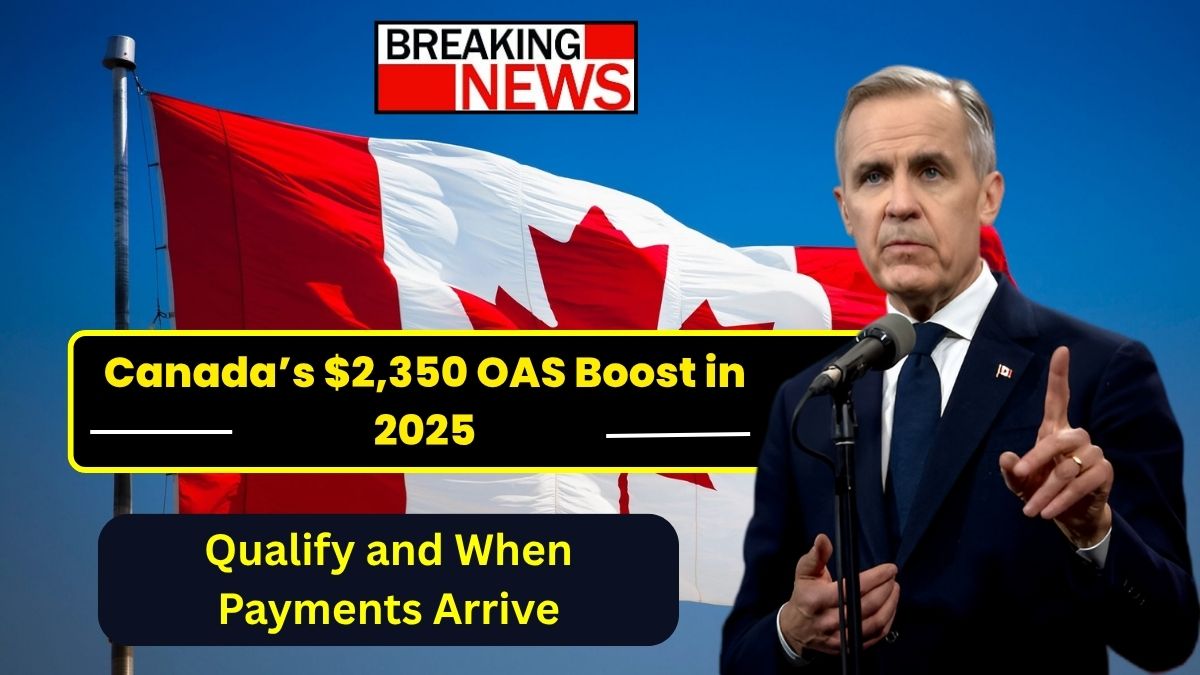Canada’s Old Age Security (OAS) program has been a reliable support system for millions of older Canadians. If you’re age 65 or older — or getting close — you probably already know how important that monthly payment is when you’re living on a fixed income.
Now, there’s a potential one-time $2,350 top-up coming in 2025 that could help a lot of seniors better handle the rising cost of living. Whether you’re already receiving OAS or getting ready to apply, understanding how this works can make a big difference in your financial future.
In this guide, we’ll break everything down for you — what the payment is, who’s eligible, when it might be paid, and how you can make the most of your OAS benefits moving forward.
What Is the OAS Program?
The Old Age Security program is one of Canada’s main government pension plans. It’s different from the Canada Pension Plan (CPP), which depends on how much you contributed while working. OAS, on the other hand, is not based on your work history or job income. It’s funded through general tax revenue, and you can receive it if you meet age and residency requirements.
If you’ve lived in Canada for at least 40 years after the age of 18, you’re entitled to the full OAS payment. But even if you’ve lived in Canada for just 10 years, you may still qualify for partial payments. That’s why OAS is often described as a universal support system for retired Canadians.
The $2,350 Payment: What’s It About?

In late 2024, the federal government began discussing a one-time $2,350 boost to OAS payments. While it hasn’t been officially confirmed yet, the idea is gaining attention.
Why the extra money? It’s meant to help seniors deal with rising prices — like groceries, rent, electricity, medication, and healthcare. For someone living on a fixed income, even a few hundred dollars can go a long way. A lump sum of over $2,000 could help cover a large expense or give you peace of mind.
This payment would be in addition to the regular OAS you receive each month. If approved, it might arrive sometime in mid-2025, possibly alongside your monthly pension.
How Much Do Seniors Receive From OAS Monthly?
Your regular OAS payment depends on your age. As of 2025, here’s what the maximum monthly amounts look like:
- Ages 65 to 74: $727.67 per month
- Age 75 and older: $800.44 per month
Back in 2022, seniors aged 75 and above received a 10% permanent increase in their OAS payments. Also, OAS is adjusted quarterly for inflation, meaning if the cost of living rises, your payment could go up slightly too.
Who Can Get the $2,350 One-Time Payment?
To qualify for this proposed extra payment in 2025, you need to meet some basic rules. These include:
- You must be 65 years old or older during the year 2025
- You must be a Canadian citizen or legal resident
- You must meet certain income limits. For example:
- If you’re 65 to 74, your net annual income must be below $148,451
- If you’re 75 or older, your income must be below $154,196
If your income goes above these limits, your OAS payment may be reduced due to what’s called the OAS Recovery Tax — often referred to as the “clawback”.
Even if you’re living outside Canada, you may still qualify if you meet residency or social security agreement rules between Canada and another country.
Not Receiving OAS Yet? Here’s How to Apply
If you’re getting close to age 65 but haven’t applied for OAS, now’s the time to start preparing. Applying early is the best way to avoid delays. Here’s how you can do it:
- Check if you’re eligible – Confirm your age, residency status, and income.
- Collect your documents – You’ll need things like your Social Insurance Number (SIN), proof of residency, and your banking details for direct deposit.
- Apply online or by mail – You can use your My Service Canada Account or fill out a paper application.
- Track your application – Log in online to check if it’s being processed.
It’s a good idea to apply 6 months before your 65th birthday, just to give plenty of time for approval and avoid any missed payments.
When Will the $2,350 Payment Be Made?
If the government approves the one-time top-up, it will likely be paid in the middle of 2025. Exact dates will be shared by the government once confirmed.
Meanwhile, here are the regular OAS payment dates for early 2025:
- January: January 29, 2025
- February: February 27, 2025
- March: March 28, 2025
Make sure your banking information is up to date so that you don’t miss any deposits.
Ways to Maximize Your OAS Benefits

Even if the $2,350 top-up doesn’t happen, there are still many ways to make the most of your OAS and ensure you get every dollar possible.
1. Defer Your OAS for Higher Payments
Did you know you can delay your OAS payments up to age 70? For every month you wait, your payment goes up by 0.6%. That’s a 36% increase if you delay from 65 to 70.
This strategy works best for people who:
- Don’t urgently need the money at 65
- Have other sources of income (like a pension or savings)
- Want to boost their monthly income later in life
2. Avoid the OAS Clawback
If your annual income goes above $86,912, your OAS starts to get reduced. You can try a few strategies to avoid this:
- Use a Tax-Free Savings Account (TFSA) instead of an RRSP for income, since withdrawals are not taxable
- Time your RRSP withdrawals carefully so they don’t spike your income in one year
- Split your pension income with your spouse to lower your taxable income
These tax-smart moves can keep your income under the threshold and help you keep the full OAS amount.
3. Look Into Other Support Programs
OAS alone might not be enough to cover all your expenses — especially with rising costs. Here are other support programs to explore:
- Guaranteed Income Supplement (GIS) – For low-income seniors, this can add hundreds more per month
- Provincial and municipal benefits – Some provinces offer housing help, prescription drug coverage, or utility rebates
- GST/HST credits – You might qualify for these if your income is low or moderate
Talk to a financial advisor or visit Canada.ca to explore your options.
Conclusion
With a possible $2,350 OAS boost in 2025, Canadian seniors may get some much-needed relief from the rising cost of living. Whether or not the payment is confirmed, there are many smart ways to maximize your retirement income — from deferring your payments to using tax strategies and applying for extra benefits.
The key is to plan ahead, stay informed, and make the most of the support that’s available. After all, retirement should be a time to enjoy your life — not worry about bills.
Keep an eye out for government updates, and don’t forget to check your My Service Canada Account for any new announcements or payment confirmations.Tools
FAQs
1. What is the $2,350 OAS boost in 2025?
The $2,350 refers to the total annual increase in Old Age Security (OAS) payments for eligible Canadian seniors in 2025.
2. Who qualifies for the OAS increase?
Seniors aged 65 or older who meet residency and income criteria set by the Canadian government are eligible.
3. When will the boosted OAS payments be issued?
OAS payments are made monthly. The increased amounts will be reflected starting from January 2025.
4. Is this OAS boost automatic, or do I need to apply?
If you’re already receiving OAS, the increase is applied automatically. No additional application is required.
5. Will this payment affect other benefits like GIS?
The OAS boost may affect income-tested benefits like the Guaranteed Income Supplement (GIS), depending on your total income.



